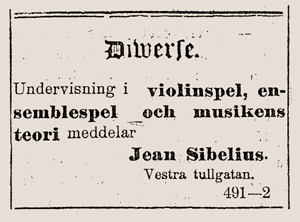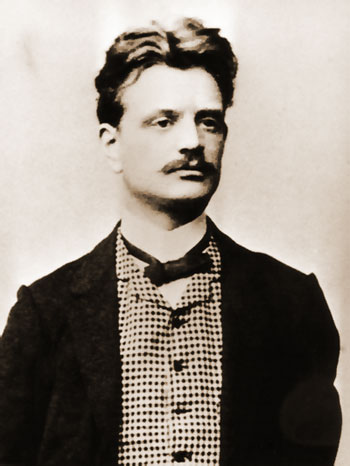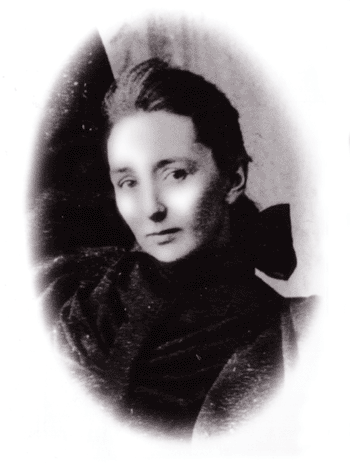In the summer 1891, Sibelius met his fiancée once again at Tottisalmi near Vaasa, at the summer residence of the Järnefelts. However, a marriage was out of the question, since Sibelius was without means and had no profession. Sibelius went to Loviisa to work on Kullervo while being looked after by his Aunt Evelina. He earned pocket money by giving private music lessons.

Jean
Sibelius's advertisement offering music lessons
On 24 November 1891 Sibelius appeared in public for the first time as a conductor. He conducted the Overture and the Scène de Ballet at a popular concert in Helsinki.
"Conducting was marvellous. I was not nervous at all. I just felt a head taller," Sibelius wrote to Paul.
"If only the compositions weren’t such shit," he added.
At the end of November, Sibelius went to Porvoo to hear Larin Paraske, a 57-year-old singer of runes (traditional verses) who was staying at the home of the clergyman Adolf Neovius. Larin Paraske, or Paraskovia Mikitiina (1833-1903), was a sensation in her time. She was from Ingria, a Finnish-speaking region near St Petersburg. About 32,000 of her runes were written down during her life. However, Sibelius did not later acknowledge
Paraske's influence on Kullervo.
Towards the end of the year, Sibelius gained more of a reputation, when Adolf Paul, in his first novel En bok om en människa, portrayed one of the principal characters,
"Sillén", as someone who lived a fast life, wrote brilliant compositions and followed his own path. Sibelius also displayed these qualities at the end of January, when he moved to Helsinki, into an apartment at the Ullanlinna bathing establishment in Kaivopuisto.
Sibelius was becoming more intimately acquainted with the conductor Robert Kajanus and he was a dedicated party-goer. However, as the spring of 1892 went on, he also proved to be an energetic worker. He actually worked day and night in order to complete Kullervo.

Kullervo, a gigantic work in five movements for orchestra, male choir and soprano and baritone soloists, was completed in April 1892. The composition of the work had taken Sibelius about a year. During the rehearsals, the choir was greatly enthused, and the orchestra, which was reinforced by German musicians, was amused by the
composer's passion as a conductor, and by the new kind of score. Yet Sibelius turned out to be an able organiser, arranging the hire of the hall, advertisements, programmes and other practical matters for the concert where Kullervo was to be performed.
The concert was attended by
"the Päivälehti circle" and by other Fennomans, people who wanted to hear a Finnish-language work with a Kalevala theme. After a raging torrent of notes lasting over an hour there was moderate applause, even if not all of the audience had understood the work. But Robert Kajanus had reserved a wreath for Sibelius bearing the words
"Siitäpä nyt tie menevi, ura uusi urkenevi." ("From here today the path is going, a bright new star the way is showing.") The authority of Kajanus drew forth a real storm of applause, and finally it was concluded that the first public performance had been a success.
The reactions of the critics varied: Oskar Merikanto from Päivälehti considered the work the most impressive Finnish composition to be written so far, but the Swedish-speaking critics had reservations. In any case, according to Aino Sibelius, it was the success of Kullervo that persuaded her parents to allow the young couple to marry. Another contributing factor was that Sibelius had been promised work as a teacher, both at the Music Institute and at
Kajanus's Orchestral School.

Aino Sibelius 1895.
The wedding took place at the
Järnefelts’
summer residence in Tottisalmi, on the 10th June 1892. After the wedding the young couple spent their honeymoon at Monola House near Lieksa. In between the kissing and cooing, Sibelius found time to compose En Saga and to revise the songs Under strandens granar, Kyssens hopp and Till Frigga (words by Runeberg).
Sibelius could afford the honeymoon because he had received a travel grant from the university to study kantele playing and rune singing in Karelia. Accordingly, after the honeymoon at Monola, Sibelius went on a journey deep into Karelia and Aino went to Kuopio to stay with her relatives.
During his journey Sibelius listened to singers such as Mikko Tolvanen, Stepnaii Kokkonen, Mikhail Wornanen and Pedri Shemeikka. It was Shemeikka who made the strongest impression on him. In his report, Sibelius surmised that the melody sung by Shemeikka was the oldest and most genuine Finnish rune melody that he had heard during his journey. The melody is made up of six antiphons in 5/4 time. Later, Sibelius would use the complete melody for the first scene depicted in his Karelia incidental music.
Sibelius returned to Kuopio in mid-August 1892. According to his recollections, the mood and atmosphere during his return journey inspired the composition Night Ride and Sunrise, which he did not write until 1908.

